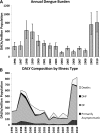Total economic cost and burden of dengue in Nicaragua: 1996-2010
- PMID: 22890033
- PMCID: PMC3516309
- DOI: 10.4269/ajtmh.2012.12-0146
Total economic cost and burden of dengue in Nicaragua: 1996-2010
Abstract
The burden of dengue in Nicaragua has been steadily rising during the last three decades; however, there have been few efforts to quantify the burden (measured in disability-adjusted life years [DALYs]) and cost to society. Using primary data from the Nicaraguan Ministry of Health (MINSA), the total cost and burden of dengue were calculated from 1996 to 2010. Total costs included both direct costs from medical expenditures and prevention activities and indirect costs from lost productivity. The annual disease burden ranged from 99 to 805 DALYs per million, with a majority associated with classic dengue fever. The total cost was estimated to be US$13.5 million/year (range: US$5.1-27.6 million). This analysis can help improve allocation of dengue control resources in Nicaragua and the region. As one of the most comprehensive analyses of its type to date in Nicaragua and Latin America, this study can serve as a model to determine the burden and cost of dengue.
Figures



Similar articles
-
Economic and disease burden of dengue in Mexico.PLoS Negl Trop Dis. 2015 Mar 18;9(3):e0003547. doi: 10.1371/journal.pntd.0003547. eCollection 2015 Mar. PLoS Negl Trop Dis. 2015. PMID: 25786225 Free PMC article.
-
Economic impact of dengue in Mexico considering reported cases for 2012 to 2016.PLoS Negl Trop Dis. 2018 Dec 14;12(12):e0006938. doi: 10.1371/journal.pntd.0006938. eCollection 2018 Dec. PLoS Negl Trop Dis. 2018. PMID: 30550569 Free PMC article.
-
Economic cost and burden of dengue during epidemics and non-epidemic years in Taiwan.J Infect Public Health. 2018 Mar-Apr;11(2):215-223. doi: 10.1016/j.jiph.2017.07.021. Epub 2017 Jul 27. J Infect Public Health. 2018. PMID: 28757293 Review.
-
Burden of symptomatic dengue infection in children at primary school in Thailand: a prospective study.Lancet. 2007 Apr 28;369(9571):1452-1459. doi: 10.1016/S0140-6736(07)60671-0. Lancet. 2007. PMID: 17467515
-
Severe dengue: the need for new case definitions.Lancet Infect Dis. 2006 May;6(5):297-302. doi: 10.1016/S1473-3099(06)70465-0. Lancet Infect Dis. 2006. PMID: 16631550 Review.
Cited by
-
Human to mosquito transmission of dengue viruses.Front Immunol. 2014 Jun 17;5:290. doi: 10.3389/fimmu.2014.00290. eCollection 2014. Front Immunol. 2014. PMID: 24987394 Free PMC article. Review.
-
Resource Use and Costs of Dengue: Analysis of Data from Phase III Efficacy Studies of a Tetravalent Dengue Vaccine.Am J Trop Med Hyg. 2017 Dec;97(6):1898-1903. doi: 10.4269/ajtmh.16-0952. Epub 2017 Oct 12. Am J Trop Med Hyg. 2017. PMID: 29141713 Free PMC article. Clinical Trial.
-
Economic burden estimation associated with dengue and chikungunya in Gujarat, India.J Family Med Prim Care. 2022 Sep;11(9):5393-5403. doi: 10.4103/jfmpc.jfmpc_694_21. Epub 2022 Oct 14. J Family Med Prim Care. 2022. PMID: 36505586 Free PMC article.
-
Economic and disease burden of dengue in Mexico.PLoS Negl Trop Dis. 2015 Mar 18;9(3):e0003547. doi: 10.1371/journal.pntd.0003547. eCollection 2015 Mar. PLoS Negl Trop Dis. 2015. PMID: 25786225 Free PMC article.
-
Assessing the Economics of Dengue: Results from a Systematic Review of the Literature and Expert Survey.Pharmacoeconomics. 2015 Nov;33(11):1107-35. doi: 10.1007/s40273-015-0294-7. Pharmacoeconomics. 2015. PMID: 26048354 Review.
References
-
- Massad E, Coutinho FA. The cost of dengue control. Lancet. 2011;377:1630–1631. - PubMed
-
- Halstead SB. Pathogenesis of dengue: challenges to molecular biology. Science. 1988;239:476–481. - PubMed
-
- Halstead SB. Dengue. Lancet. 2007;370:1644–1652. - PubMed
-
- Torres JR, Castro J. The health and economic impact of dengue in Latin America. Cad Saude Publica. 2007;23((Suppl 1)):S23–S31. - PubMed
Publication types
MeSH terms
Grants and funding
LinkOut - more resources
Full Text Sources
Medical
Research Materials

